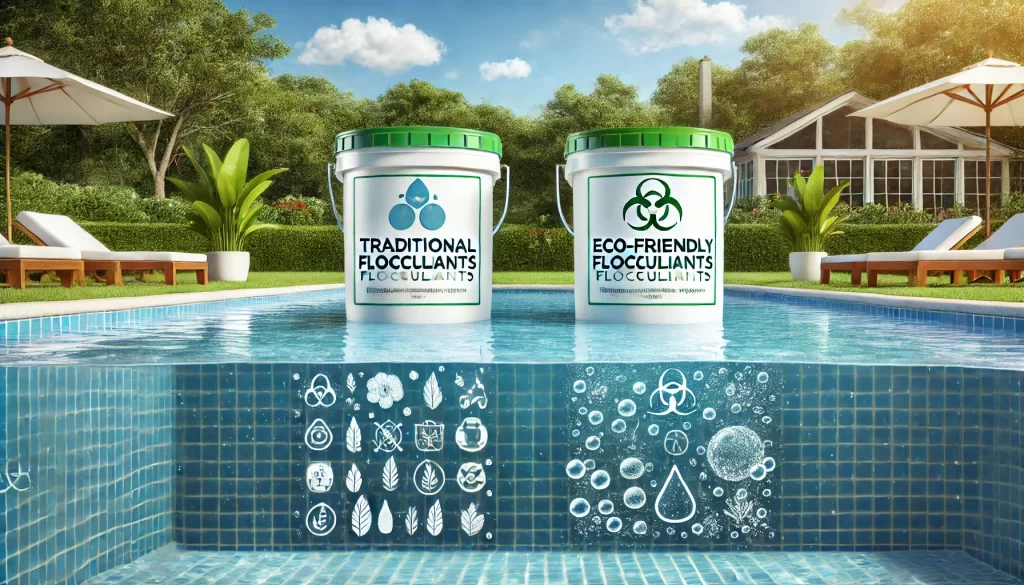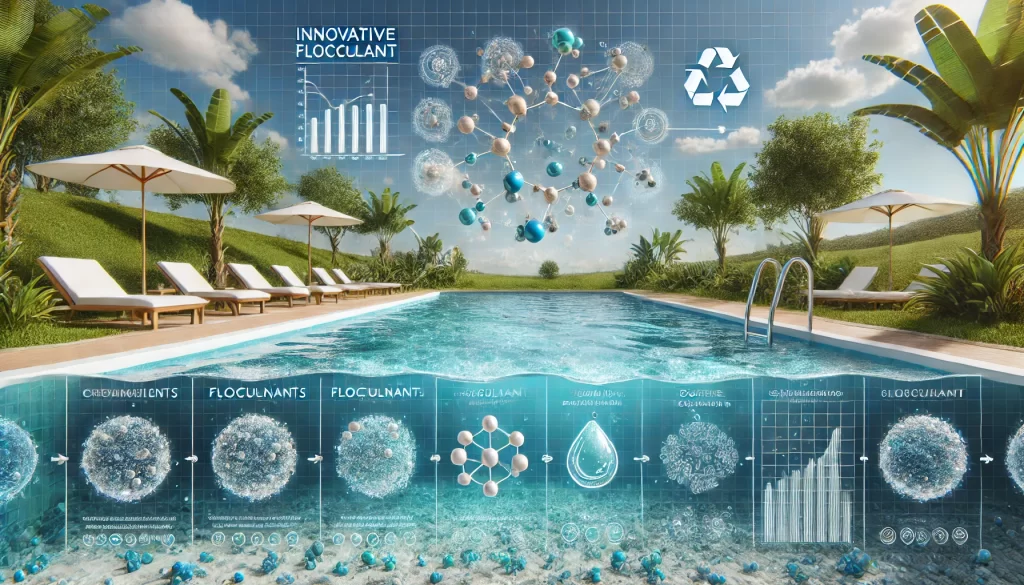Pool water treatment is essential for clear and safe swimming pools. Flocculation water treatment plays a vital role in this process. Flocculants for pools are key chemicals that help suspended particles coagulate. They settle and keep the pool water clear. This article explores flocculants’ role in pool treatment, new innovations, and their environmental impact.

I. What Are Flocculants and How Do They Work?
1. The Role of Flocculants in Water Treatment
Flocculants are chemicals that cause suspended particles to clump together. These particles are often too small to see. Traditional filtration systems can’t remove them effectively. Once flocculants are added, particles form larger clumps. These can then be filtered out or settle to the pool’s bottom. This process is called flocculation.
2. How Flocculation Works
Flocculation works by neutralizing electrical charges on water particles. These particles often carry negative charges and repel each other. Flocculants are positively charged, neutralizing the negative ones. This reduces repulsion and helps particles stick together. With these chemical reactions, water quality improves quickly.
II. Limitations of Traditional Flocculants
1. Effectiveness and Chemical Balance Issues
Traditional flocculants, like aluminum or iron salts, have been used for years. They are effective at coagulating suspended particles. However, they struggle with certain contaminants, like dissolved organic matter. Overuse can disrupt the pool’s chemical balance. This affects the water’s pH and alkalinity.
2. Environmental Risks of Traditional Flocculants
Traditional flocculants, such as aluminum and iron salts, can degrade and produce harmful byproducts. These byproducts pose significant environmental risks, especially when they enter natural water bodies like lakes and rivers. The accumulation of these substances can disrupt aquatic ecosystems, highlighting the urgent need for more environmentally friendly and sustainable alternatives in water treatment processes.
III. Technological Breakthroughs in Innovative Flocculants
1. Bio-Based Flocculants: A Natural Solution
Recent innovations have led to bio-based flocculants. These new products increase flocculation efficiency and reduce environmental harm. Many pool operators now use natural or bio-based flocculants. These are made from renewable sources like plants. They keep water clean while minimizing chemical residues.
2. Chitosan: An Eco-Friendly Example
Chitosan, a natural flocculant derived from the shells of crustaceans such as shrimp and crabs, possesses strong flocculating properties. It effectively removes suspended particles and various contaminants from water. More importantly, it is fully biodegradable, making it an environmentally friendly and sustainable option for pool water treatment.
3. Nanotechnology in Flocculants
Nanotechnology has opened new possibilities for flocculant innovation. Nano-scale flocculants control the coagulation of particles more precisely. This improves treatment efficiency and reduces harmful byproducts. These nanomaterials can be engineered to adsorb specific contaminants.
IV. Impact on the Environment and Health
1. Potential Risks of Traditional Chemicals
Traditional flocculants often leave behind chemical residues in the water after use. These residues can seep into natural water sources, potentially harming aquatic ecosystems and disrupting the balance of local wildlife. Additionally, improper or excessive use of these chemicals can irritate swimmers’ skin, eyes, and respiratory systems. This underscores the growing need for safer, eco-friendly alternatives.
2. Benefits of Innovative Flocculants
Innovative flocculants, such as chitosan, are gaining popularity due to their environmental benefits. Unlike traditional chemical-based options, these natural flocculants are biodegradable and do not release long-lasting pollutants into the environment. By minimizing harmful chemical emissions and reducing the overall environmental impact, they present a much more sustainable solution for pool water treatment. Additionally, they contribute to cleaner and safer water systems, supporting both human health and aquatic life. Their eco-friendly nature makes them a preferred choice for those seeking greener alternatives in water management.
V. How to Choose the Right Flocculant?
1. Factors to Consider When Selecting a Flocculant
When choosing a flocculant, consider the water’s quality. Pools with more organic matter may need bio-based flocculants. The pool’s size and usage frequency also matter. Commercial pools may need stronger flocculants for faster purification.
2. Economic and Long-Term Benefits
Though innovative flocculants may cost more upfront, they offer long-term benefits. They reduce the risk of chemical residues and potential maintenance costs. Their environmental advantages also make them a more sustainable choice.

VI. Conclusion
Flocculants are essential for maintaining clean pool water. They clump small particles together, making them easier to remove. Traditional flocculants work but have environmental limitations. Luckily, innovative flocculants are emerging, particularly natural and bio-based options. They improve water treatment while reducing the environmental impact.
Technological advancements promise safer and more efficient pool water treatment. These innovations are making pool management easier and greener. Innovative flocculant technology is paving the way for sustainable water treatment worldwide.
